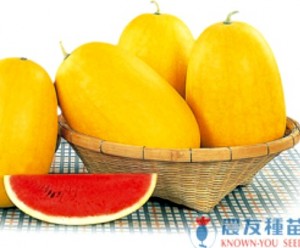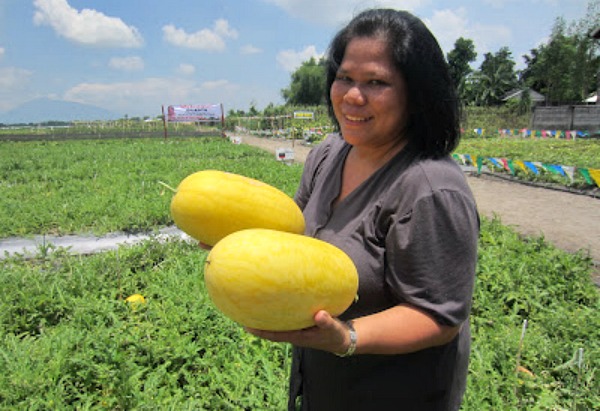 Diana watermelon is a new breed of fruit developed by Known-You Seed of Taiwan which is distributed in the Philippines by Harbest Agribusiness owned by Toto Barcelona. The Diana watermelon can be grown even during the rainy season because of its unique feature.
Diana watermelon is a new breed of fruit developed by Known-You Seed of Taiwan which is distributed in the Philippines by Harbest Agribusiness owned by Toto Barcelona. The Diana watermelon can be grown even during the rainy season because of its unique feature.
Diana watermelon has an attractive golden-yellow rind and uniform oblong shape. The vigorous plant is early and productive, with strong fruit-setting. Flesh is red, tender and juicy, with 12% sugar content. The rind is thin but good for shipping and storage. The average weight is 2.5 kilos. The plant is productive and can be harvested as early as 60 to 65 days after transplanting.
 JENNIFER REMOQUILLO, national coordinator of the High Value Crops Development Program, shows two fruits of Diana watermelon harvested at the training center in Concepcion, Tarlac.
JENNIFER REMOQUILLO, national coordinator of the High Value Crops Development Program, shows two fruits of Diana watermelon harvested at the training center in Concepcion, Tarlac.
How to grow Diana Watermelon:
TIME OF PLANTING
Watermelons are commonly grown where there is a short period of rain and a long duration of hot weather (dry season). In the Philippines, this is usually from December to March, when the temperature ranges from 25ºC to 30ºC. The plants do best in loam or sandy loam soil with adequate water sources. The Diana watermelon can be planted during the rainy season (off season) because of its unique feature.
SEED GERMINATION
- Soak the seeds in clean water from 30 minutes to an hour.
- Wrap the seeds in wet cloth and put these in a box (seed incubation) for 24 to 36 hours.
- Transfer the pre-germinated seeds to a seedling tray with 104 holes. Make sure that the rooted part is in the medium. Use Growell Media or soil-less media as a planting medium.
- Water the seedlings twice a day.
- Place the seedlings in a nursery to avoid pests, heavy rains, and strong winds.
- After 10 to 15 days, or when 2 to 3 leaves have developed, the seedlings are ready to be transplanted.
LAND PREPARATION
- Plow the area until it is clean and the soil is tilled.
- Measure 1 meter for the plot, 0.5 meters for the canal, and 3 meters for the crawling area.
- The plot must be elevated 6-8 inches. Initial fertilizer may be applied.
- To prevent the growth of weeds, use Agri+Plus silver-black plastic mulch to cover the plot.
TRANSPLANTING
- Measure hole spaces of 0.8 to 1 meter in each plot.
- Transplant one seedling in each hole. Seeds can also be directly planted in the hole.
- Transplanting can be done late in the afternoon or early in the morning.
- Water the plants right after transplanting them.
FERTILIZER APPLICATION
Basal Fertilizer
The following are applied for every 20 meters (length) of each plot as basal fertilizer:
20-25 kg. organic fertilizer; 1-2 kg. complete (14-14-14); 0.5-1 kg. calcium nitrate; 0.5-1 kg. muriate of potash (0-0-6); 100 grams (g) boron; and 100 g. magnesium
DRENCHING
- Drenching is done 7 to 10 days after transplanting.
- Dilute the fertilizer with 16 liters of water.
- Take 150 ml. of the diluted solution and apply it to the base of the plant.
- Avoid wetting the leaves with fertilizer.
- Apply every week based on the schedule below:

IRRIGATION
To ensure proper growth of the plants, irrigate them. At the flowering and fruit setting stage, which is 30 to 35 days after transplanting, reduce the water supply and increase it when the fruits start to develop. One week before harvest or 60 to 65 days after transplanting, reduce irrigation.
During the rainy season, drainage canals should be provided to facilitate drainage and manage water overflow to prevent root rot.
PRUNING AND FRUIT SETTING
To achieve better yield and uniform time of harvest, perform the following:
- Remove or cut the shoots when fourth true leaf has appeared to encourage development of the secondary vine. This is done 10 to 15 days after transplanting.
- Leave four secondary vines in each plant. Remove all flowers, fruits, and shoots from each secondary vine starting from the fourth leaf (node) downwards.
- Let the fruit developed from the fifth leaf (node) onwards.
- Each plant may produce 4 to 5 fruits.
PESTS AND DISEASES
The most common watermelon pests are aphids, army worms, lady beetles, and spider mites. Chemicals like lambdacyalothrin, methomyl, and carbaryl are used to eradicate these insects.
During the rainy season, the diseases that commonly afflict watermelons are root rot and downy mildew. These can be prevented with the use of systemic fungicides like metalaxyl and mancozeb.
HARVEST
The following indicate when the fruit is ready to harvest:
- Count 60 to 65 days after transplanting, or 30 to 40 days from flowering.
- An unripe fruit is heavy; a ripe one is lighter.
- The leaf nearest the fruit will go yellow and dry up.
- The traditional way to determine whether a watermelon is ready for harvest is by tapping the fruit. If it sounds like you’re tapping your chest, the fruit is ripe.
Sources: www.agrizaccess.com, trc.dost.gov.ph; Photos: www.knownyou.com, www.agrizaccess.com